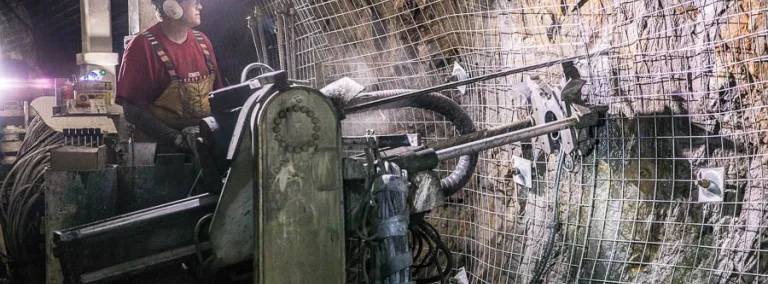Underground Maintenance keeps science up and running
Underground science cannot happen at our facility without safe access and UMC is on the front lines providing support.
Researchers go deep underground to solve the mysteries of our universe, understand the earth and seek out extreme life forms. But they wouldn’t get far without the knowledge and expertise of the Underground Maintenance Crew (UMC).
“Underground science cannot happen at our facility without safe access and UMC is on the front lines providing support in a number of ways,” said Jaret Heise, director of Science at Sanford Lab.
Members of UMC are critical to the success of Sanford Lab. They inspect the rock in high-traffic areas, install ground support, maintain ventilation systems and water inflow and do annual level inspections to ensure work areas remain safe.
“This team has extensive knowledge of the underground environment,” said Bryce Pietzyk, director of Underground Access. “They’ve been a part of Sanford Lab for years and most of them were miners here and at other mines. They know how to read the rock and they know how the systems interconnect.”
In 2017, UMC completed work in the West Lab Access Drift, the main pathway between the Yates and Ross campuses. With construction of the Long-Baseline Neutrino Facility just around the corner, traffic is expected to increase dramatically and the project was given high priority.
Over a period of three years, infrastructure technician Mike Oates installed thousands of rock bolts and half a mile of welded wire mesh from the Yates Station to Governor’s Corner—a distance of 2600 feet. While working, Oates had to ensure safe access through the drift for researchers and others working underground.
“He did an excellent job on this project and kept the area safe for egress,” Pietzyk said.
In addition to ensuring safe access through the drifts, the UMC maintains ventilation systems throughout the facility. Currently, they are working on opening up what is called the 31 exhaust, a raise on the 4850 Level that directs air up to the 4100 Level then ties into a network of drifts and raises that eventually reaches the Oro Hondo fan.
“Opening the 31 exhaust route gives us flexibility to adjust flow rates underground as we continue to maintain ventilation pathways,” Pietzyk said.
Other projects include water inflow control and removing miles of “legacy” pipe in areas used for science.
“Some of this pipe has been around for decades and is deteriorating,” Pietzyk said. “We’re removing it to ensure safe access.”
When it rains, the Open Cut acts like a funnel. Water collects in a deep pool and must be pumped out. This year, the UMC completed a water inflow project that collects some of that water at higher levels, reducing the cost of pumping water to the surface.
And on nearly every project, the UMC works closely with other departments to ensure work is done properly and safely.
“The de-watering, mechanics, and electrical crews do quite a few projects underground with the UMC group,” said Tim Baumgartner, director of Infrastructure. “The crews work together on everything from the pump rooms to installing fiber and electrical cables, waterlines, and ventilation systems. It is great to know that we can always count on the UMC folks.”
UMC plays a key role in several research projects as well, including Davis Campus renovations that will support the next-generation dark matter experiment, LUX-ZEPLIN (LZ). They’ve also lent their expertise to SIGMA-V, a geology experiment that is studying geo-thermal energy, and biology researchers who are gathering samples and conducting experiments on other levels of the facility.
“Bottom line is that the UMC crew helps ensure safe and successful operation of many of the experiments at our facility,” Heise said. “I know that the researchers appreciate their dedication and hard work.”
